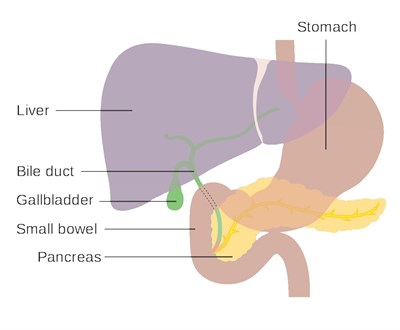Gallstones are stones that form in the gallbladder and they are
very common in the UK. Often, they will not cause any symptoms.
However, in certain patients, they can cause a variety of symptoms
or problems. These are explained below.

Figure 1. Anatomy of the gallbladder region.
Pain
Gallstones can cause pain. The most common pattern is called
'biliary colic'. This usually means that a patient will get
intermittent pains, often in the upper middle or upper right side
of the abdomen, and this can spread round to the back. Typically,
this will last for a few hours, before slowly easing. Associated
with this pain, patients may feel hot and sweaty, or sick, with
some patients also vomiting. These episodes often occur at night,
or they can also happen half an hour or an hour after eating,
particularly after foods containing lots of fat.
Occasionally, patients may get pain similar to that described
above, but it does not settle after a period of 4-6 hours. Along
with the pain, some patients may experience a high temperature.
This can occur when the gallbladder becomes inflamed, and this is
then called 'cholecystitis'. Your doctor will look for certain
signs of inflammation, when examining you and also using blood
tests. Because of the inflammation, cholecystitis is usually
successfully treated with a course of antibiotics. However,
sometimes antibiotic treatment is not successful, and a surgical
procedure is required.
Similar pains can also be caused by gallstones blocking the
gallbladder permanently, or if gallstones manage to move from the
gallbladder into the bile ducts, which are tubes taking bile from
the gallbladder to the bowel. In these cases, gallstones can cause
other problems such as jaundice, pancreatitis, or cholangitis.
Jaundice
If a stone passes from the gallbladder to the main bile duct and
causes a blockage, it may cause a person to become jaundiced. This
means that they have high levels of a particular chemical in their
body that causes their skin and whites of their eyes to go yellow,
as well as turning their urine a dark yellow or brown, and their
faeces may become pale and grey. Often this is associated with
general itchiness. Confirming the problem often requires blood
tests and special scans. Stones in the bile duct are often then
treated with a special endoscopy (camera test with a telescope
inserted through the mouth into the bowel) or operation.
Pancreatitis
Pancreatitis means inflammation of the pancreas. This is a gland
in the back of the upper abdomen. The pancreas normally controls a
person's blood sugar, as well as producing chemicals to digest
food. Gallstones passing through the bile duct are the most common
cause of pancreatitis in England. People who develop pancreatitis
usually have severe pain in the upper abdomen and may go through to
their back, which comes on quickly and stays there for hours. It is
often associated with nausea and vomiting. The diagnosis is usually
confirmed with a blood test, although sometimes a scan is required.
The condition of pancreatitis can be very variable, with many
patients having very mild disease that settles quickly. However, it
can be life-threatening, and in some patients requires treatment in
intensive care and a long hospital stay.
If pancreatitis develops due to gallstones and a patient is fit
for surgery, we aim to remove the gallbladder with a surgical
procedure as soon as we can, usually within 2 weeks. However, in
severe cases of pancreatitis, there may be a delay to wait for the
inflammation to settle. In patients not fit for surgery, a special
endoscopy may be performed to reduce the risk of further attacks of
pancreatitis.
Cholangitis
Cholangitis is an infection in the bile ducts, and can occur in
patients with a gallstone that is blocking the bile duct. This can
result in a very serious, life-threatening infection requiring
strong antibiotics, tests to confirm the diagnosis, and urgent
treatment to relieve the blockage. This is usually done with a
special endoscopy.